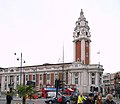South London: Difference between revisions
m →Associated organisations: Layout |
m Layout |
||
| Line 58: | Line 58: | ||
File:Hampton Court RJL.JPG|Hampton Court Palace |
File:Hampton Court RJL.JPG|Hampton Court Palace |
||
</gallery> |
</gallery> |
||
| ⚫ | |||
<div style="column-count:2;-moz-column-count:2;-webkit-column-count:2"> |
|||
| ⚫ | |||
</div> |
|||
==Associated organisations== |
==Associated organisations== |
||
| Line 68: | Line 73: | ||
*[[South London Theatre]] |
*[[South London Theatre]] |
||
</div> |
</div> |
||
| ⚫ | |||
| ⚫ | |||
{{Sub-regions of London}} |
{{Sub-regions of London}} |
||
Revision as of 20:03, 17 February 2009

South London is the southern part of London, England. The area it covers is defined differently for a range of purposes.
Division by the Thames
At its widest extent, south London is the part of Greater London that is south of the River Thames. This includes the historic central areas of Southwark and Bankside and maritime Greenwich. The area has little of the London Underground network, but has a much more extensive suburban railway system than North London[1] and is the location of all of London's tram services. This area is made up of the London boroughs of Bexley, Bromley, Croydon, Greenwich, Kingston, Lambeth, Lewisham, Merton, Southwark, Sutton and Wandsworth. This definition is used by the Boundary Commission for England.[2] The London Borough of Richmond upon Thames includes sections on both sides of the River Thames and the boundary commission class the entire district as part of South London.[2] In 1965 Greenwich, Lambeth, Lewisham, Southwark and Wandsworth were designated Inner London boroughs and Bexley, Bromley, Croydon, Kingston, Merton and Sutton were designated Outer London boroughs.[3]

Sub-region
For the purposes of the London Plan, the South London sub-region consists of Bromley, Croydon, Kingston, Merton, Richmond and Sutton.[4] In 2001 this area had a population of 1,329,000.[5] This definition is used by organisations such as Connexions.[6]
Colloquial use
Aside from the official definitions, South London refers to areas south of Central London and the River Thames. This area overlaps the informal Central, South East and South West London areas. Some of these districts are included in the South Eastern and South Western postcode areas. This area is included in all or part of the following boroughs, listed with postcode areas, direction from Charing Cross (the nominal centre of London), sub-region they are part of for planning purposes, and London Assembly constituencies:
| London borough | Postcode areas | Charing Cross | Sub-region[5] | London Assembly[7] | |
|---|---|---|---|---|---|
| Bexley | DA, SE | east south-east | East | Bexley and Bromley | |
| Bromley | BR, SE | south east | South | Bexley and Bromley | |
| Croydon | CR, SE, SW | south | South | Croydon and Sutton | |
| Greenwich | SE, DA, BR | east south-east | East | Greenwich and Lewisham | |
| Kingston | KT, SW | south west | South | South West | |
| Lambeth | SE, SW | south | Central | Lambeth and Southwark | |
| Lewisham | SE, BR | south east | East | Greenwich and Lewisham | |
| Merton | CR, KT,SM, SW | south west | South | Merton and Wandsworth | |
| Richmond | SW, TW | south west | South | South West | |
| Southwark | SE | south | Central | Lambeth and Southwark | |
| Sutton | SM | south west | South | Croydon and Sutton | |
| Wandsworth | SW | south west | Central | Merton and Wandsworth | |
The South West London Assembly constituency additionally includes the London Borough of Hounslow.
Gallery
-
The Globe Theatre, Southwark
-
Eel & Pie House, Peckham
-
Peckham library
-
Clapham Common tube
-
The Oval, Kennington
-
MI6 HQ, Vauxhall
-
Greenwich Naval College
-
Hampton Court Palace
References
- ^ Wolmar, Christian. The Subterranean Railway: How the London Underground Was Built and How It Changed the City Forever. Atlantic Books. ISBN 1-84354-023-1.
- ^ a b Boundary Commission for England - South London Boroughs
- ^ Office of Public Sector Information - London Government Act 1963 (c.33) (as amended)
- ^ Greater London Authority, The London Plan: Sub-Regional Development Framework - South London
- ^ a b Greater London Authority, The London Plan: The Sub Regions
- ^ Connexions - South London
- ^ London Assembly - London Assembly Constituency Information. Retrieved on 22 February 2008.
Associated organisations











